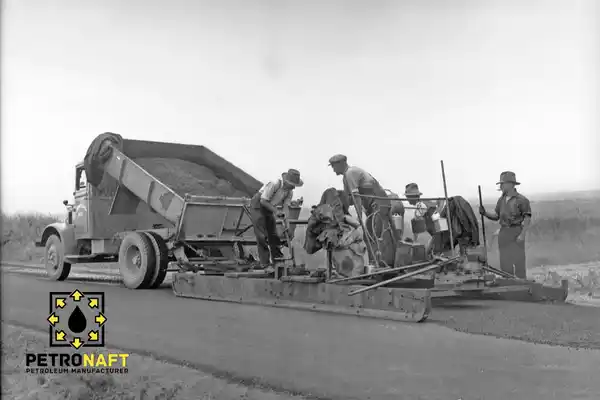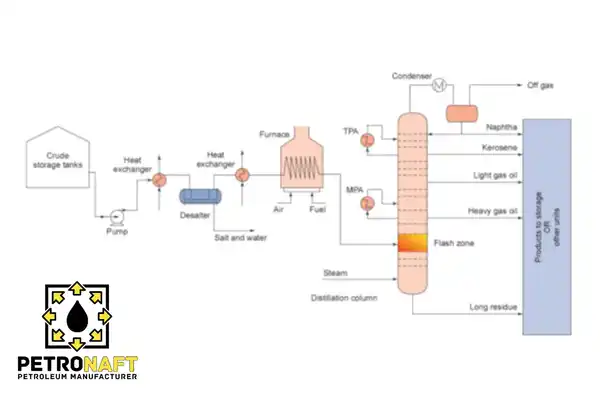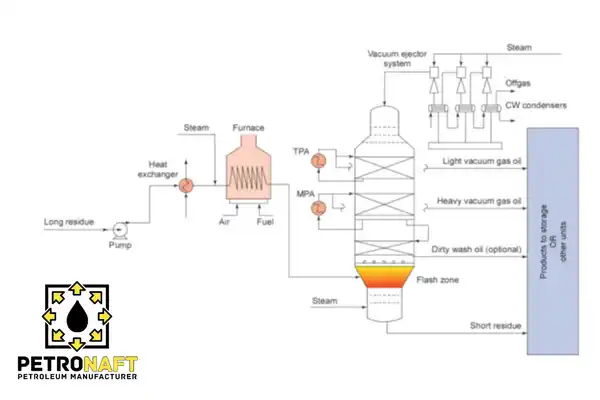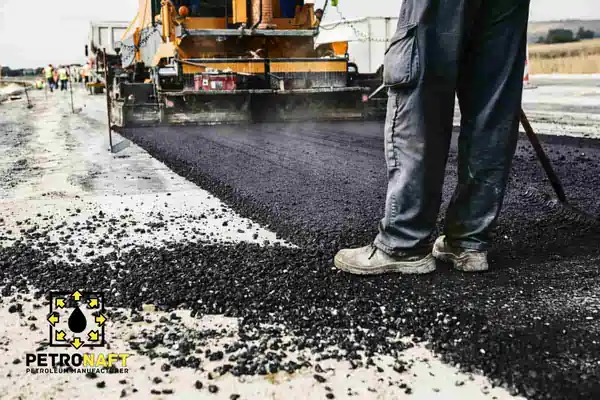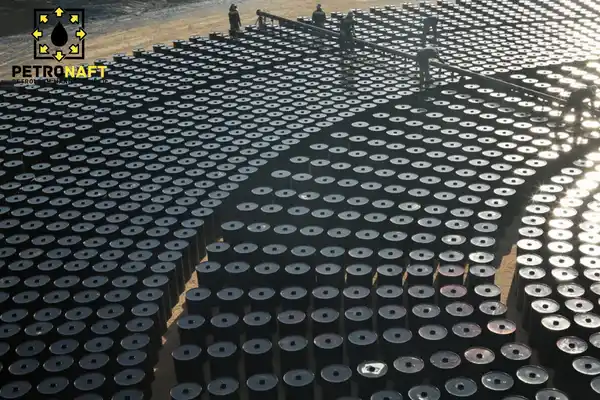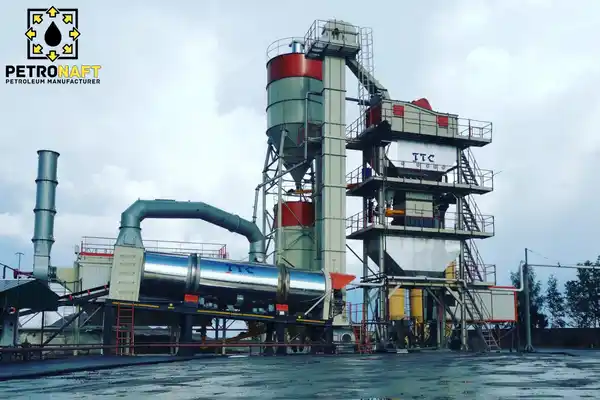BITUMEN AND ASPHALT
Content Overview
INTRODUCTION OF BITUMEN AND ASPHALT
Bitumen and asphalt are materials that many people sometimes use the names of these two materials interchangeably, but in fact, bitumen is a material that is used in the manufacture of asphalt and plays the role of adhesion between asphalt granules and has many other useful properties that add to this composition. In the following, explanations about bitumen and asphalt are provided so that the difference between these two compounds can be easily recognized. PetroNaft Co. is a specialized manufacturer of all types of bitumen.
LIST OF PRODUCTS
- BITUMEN OXIDIZED (BLOWN ASPHALT)
- BITUMEN PENETRATION
- VISCOSITY GRADE BITUMEN (VG)
- BITUMEN CUTBACK (MC-RC-SC)
- BITUMEN EMULSION
- BITUMEN PERFORMANCE GRADE (PG)
- BITUMEN POLYMER MODIFIED
- CRUMB RUBBER MODIFIED BITUMEN (CRMB)
WHAT IS BITUMEN?
Bitumen is a naturally occurring hydrocarbon that is primarily obtained from crude oil during the refining process. It is a complex mixture of organic materials, including various hydrocarbons such as polycyclic aromatic compounds and heterocyclic compounds. Its unique composition gives bitumen its characteristic properties, such as high viscosity, adhesion, and water resistance. Due to its excellent waterproofing capabilities, bitumen is widely used in the construction industry for roofing, waterproofing membranes, and sealing applications. Its versatility also extends to the automotive sector, where it is used for manufacturing tires and soundproofing materials.
BITUMEN HISTORY
We start the history of bitumen with the definition of bitumen. Bitumen is a dark, gummy, non-crystalline material that dissolves in carbon disulfide. It has a characteristic smell of tar (CS2). This understanding of what bitumen is may be found in a variety of different sources. The ancient Sumerian civilization was the first known society to become familiar with bitumen. Around 4000 BC, the members of this culture began using this substance to seal the towers in their civilization. The usage of bitumen continued after them with the Egyptians and Babylonians. Bitumen was used to a variety of uses by the ancient Egyptians, including embalming and sealing the bodies of deceased people.
The term “mummy” originates from the Persian word “mum,” which has been anglicized to “mummy” in English. Mummy refers to a mummified body. The ancient Egyptians were big fans of this technique, which is being used today in order to make people live forever. Through a variety of techniques including a material that was mostly composed of bitumen, the ancient Egyptians preserved the dead using embalming. They used time-honored techniques to extract the bitumen necessary for embalming from the natural bitumen mines that were located in those regions.
Recent archaeological research on the bitumen found in Egyptian mummies has shown that the ancient Egyptians received the bitumen they need either from the natural bitumen mines located on the mountain (Zit) that surrounds the Suez Canal or from the mines that are located nearby (Dead Sea).
BITUMEN OTHER NAMES
Blacktop, Tar, Tarmac, Asphalt, Pitch, Asphalte, Asphalton, Asphaltum
BITUMEN PRODUCTION
Crude oil refers to unrefined hydrocarbons, the thick liquid that is extracted from the earth and is known as crude oil. Crude oil is a fossil fuel, which means it was created millions of years ago from decaying plants and animals that formerly inhabited ancient seas. The majority of crude oil-bearing regions were previously seafloors. The color of crude oil ranges from transparent to glossy black, and its viscosity ranges from water to almost solid.
Because crude oil includes hydrocarbons, it has various uses. Hydrocarbons are carbon- and hydrogen-containing molecules with a variety of lengths and topologies, including straight chains, branched chains, and rings. Crude oil is a complex combination of hydrocarbons that varies in many aspects, including molecular weight, carbon chain length, and boiling range. Prior to use, crude oil must be broken down into shorter chains, some of which are then chemically or physically changed. Frequently, these goods are combined to create final goods. This technique produces bitumen as one of its components.
Production of bitumen by partial distillation of crude oil:
First in the process of refining crude oil is fractional distillation, which physically transforms the crude oil into components with varying boiling points. This is accomplished in separation or distillation towers, which are towering steel structures. Perforated horizontal steel trays divide the inside of the distillation tower, allowing steam to ascend the tower. Above these pores are little domes known as bubble caps, which divert the vapor downwards so that the bubble passing through them condenses into a liquid. This has the added benefit of improving separation efficiency and decreasing tower height. In the furnace, crude oil is heated to a temperature between 350 and 380 degrees Celsius before entering the bottom portion of the tower, which has a little greater pressure than air pressure.
The material entering the tower is a combination of liquid and vapor; the liquid consists of components with a boiling point above that of crude oil, while the vapor consists of components with a boiling point below it. As they ascend through the openings in the trays, the vapors lose heat and reach the top of the tower. When each component reaches a tray where the temperature is slightly below its boiling point, it transforms back into a liquid. As components of differing grade gather on the trays, they are continually extracted by tubes. At the top of the distillation tower, the lightest components of the crude oil remain as vapor and are collected.
As side streams, heavier components exit the tower. They stay at the base of the tower because the heaviest components remain as liquids. Propane and butane, which are both gaseous at atmospheric pressure and temperature, are the lightest components generated by crude oil distillation.
As one descends the tower, naphtha (a somewhat heavier material) is generated. Naphtha is used as a raw ingredient in the gasoline and chemical industries. Kerosene is manufactured at the base of the tower. Kerosene is used largely as an aviation fuel and to a lesser degree as a home heating fuel.
As fuels for diesel engines and central heating, oil and diesel are used. Before it can be utilized as a raw material for the manufacturing of bitumen, the heaviest component produced from crude oil distillation is a complicated combination of hydrocarbons with a high molecular weight that requires additional processing. Explanation: atmospheric distillation is another name for fractional distillation carried out at atmospheric pressure.
A vacuum distillation tower is used to further distill the residue with a longer carbon chain at lower pressure.
This is done in a vacuum of 10 to 100 mm Hg and at temperatures between 350 and 425 °C in order to create a portion of diesel and distillate components, as well as a bottoms residue called short-carbon residue. If this second distillation is conducted with just a little rise in temperature, cracking or thermal breakdown of the residue with longer carbon chains will occur; thus, the pressure must be decreased. More than twenty distinct varieties of bitumen are manufactured using short residue as a basic material.
BITUMEN APPLICATIONS
It is believed that the current annual use of bitumen around the globe is something in the neighborhood of 102 million tons. About 85 percent of all of the bitumen that is produced is utilized as a binder in asphalt for the construction of roadways.
When building or maintaining the following, bitumen is often used:
• Highways
• Airport taxiways
• Footpaths / Pedestrian Routes
• Parking lots and racetracks
• Tennis courts and roofs
• Damp proofing
• Dams Reservoir and pool linings
• Sound insulation
• Pipe linings
• Cable Insulation
• Building Waterproofing Paints
• Waterproofing beneath the tile
BITUMEN PRICE
Stay updated with the latest prices of our wide range of Petronaft bitumen types. Explore the information on this page for weekly price updates and make informed decisions for your projects:
Pricing Trends in the Bitumen Market
WHAT IS ASPHALT?
Asphalt is a composite substance that is produced by combining gravel, sand, and bitumen together. The name “asphalt” comes from the French and refers to this material. The building of roads and streets is by far the most common use of asphalt. In accordance with the temperature at which it is combined, asphalt might be one of three distinct varieties: hot asphalt, cold asphalt, or protective asphalt. In the following, after providing a concise review of the evolution of asphalt, we will discuss its many varieties as well as the applications for each.
ASPHALT HISTORY
A lot of years have passed since asphalt mixture was used, and it is important to point out that the history of asphalt and the building of the very first asphalt road dates back to 604-625 BC. John Metcalfe was the first person to successfully apply asphalt to a road surface and is credited with inventing the material. The development and improvement of asphalt proceeded, and in the early 1820s, two Scottish engineers named John Loudon McAdam and Thomas Telford were the ones who came up with the idea of contemporary asphalt roads consisting of a single layer. In point of fact, these two Scottish engineers are generally acknowledged as the people who first developed modern asphalt. After the year 1900 and throughout the 20th century, there was a greater focus placed on laboratory controls, and more tests were conducted on asphalt. As a result of the rise in the volume of traffic on the roads, there was a demand for asphalt with a higher resistance level, as well as the investigation of methods that could prevent it from cracking.
It has been shown through years of research that the modification of asphalt with sulfur compounds is one of the most effective ways to strengthen the resilience of asphalt. It is also highly beneficial to employ more adhesive elements that are stronger, such as asphalt modifiers like Gilsonite and synthetic compounds, in order to stop the asphalt pavement from cracking.
One of the reasons for the widespread usage of asphalt is the fact that it is completely recyclable and is thus regarded as the most recycled building material.
TYPES OF ASPHALT, HOW TO PRODUCE IT, AND THEIR USES
On the basis of how it is used and combined, asphalt may be broken down into three primary categories: hot asphalt, cold asphalt, and protective asphalt. Each of these categories also has a variety of subcategories, which we will go over in more detail below.
Hot asphalt:
Asphalts are often thought to be composed of hot-mixed bitumen and stone components, which are then put on roads while still hot and allowed to cool. This asphalt is composed of many layers, including topka asphalt (the top layer), binder (the lining), bitumen base (the layer of bitumen that is put below the asphalt), asphalt sand, and porous asphalt, all of which are used in the process of road paving.
Cold asphalt:
You can make cold asphalt by combining aggregates with soluble bitumen or by heating bitumen to the temperature of the ambient air. Once you have cold asphalt, you may distribute it and then condense it at the same temperature. When aggregates are combined with bitumen, the aggregates may be wet; however, if soluble bitumen is used, the aggregates must be dry. The benefit of using cold asphalt is that it may be kept in the workshop and utilized at a later time, or it can be transported and disseminated across vast areas.
It is possible to utilize cold asphalt in all pavement layers so long as all of the design standards and road traffic limits are adhered to. Cold asphalt may be used in the top, liner, and bituminous layers for roadways that experience low to medium traffic; for roadways that experience significant traffic, this asphalt can also be utilized on a bitumen basis.
Protective asphalt:
The application of bitumen over roadways made of soil, sand, asphalt, and concrete, which is then followed by the pouring of aggregate bitumen, is what is meant by the term “protective asphalt.” Protective asphalt may also be applied by the use of pre-made asphalt mixes, such as bituminous slurry or micro surging. This is an alternative approach. In the production of this kind of asphalt, soluble bitumen, aqueous bitumen, or pure bitumen that has a low viscosity are the materials of choice.
It is possible to make the road bed impermeable by using protective asphalts, which also strengthen the resistance to sliding and abrasion and may be used to temporarily repair asphalt or concrete surfaces that are already in place. This approach is not only quicker and simpler, but it also needs less apparatus and equipment than the hot asphalt method. Because of these characteristics, protective asphalt ends up being a more financially viable option than hot asphalt.
THE FOLLOWING IS A QUICK SUMMARY OF THE BITUMEN TYPES MANUFACTURED BY PetroNaft
BITUMEN OXIDIZED (BLOWN ASPHALT):
Oxidized Bitumen, blown asphalt, and blown bitumen are generated by continuous or intermittent blowing operations. In a controlled environment, air is blown over heated penetrating-grade bitumen to manage the oil content of the bitumen as it oxidizes. Two figures represent the midway points of the softening point and penetration ranges for each grade designed for a particular application.
The high softening temperatures of Oxidized Bitumen make it an appropriate sealant for avoiding leakage in high-temperature applications. Bitumen of the blown grade must be split into small pieces (for the blown grade in cake form) and heated to an application temperature of 220° to 230°C with care. Oxidized Bitumen is used largely in the piling industry as an anti-slip compound for the manufacturing of undercarriage sealants in the automobile industry. In addition to being used to produce roofing and sound-dampening felts, it is also used as a sealant and joint filler. Additionally, oxidized bitumen is used to produce bituminous marine mastic, which is used to seal the joints between oil and gas pipes.
BITUMEN PENETRATION:
The refined bitumen used in the various penetration grades has varying viscosity. Penetration bitumen, sometimes known as petroleum grade bitumen, is a semi-hard, black substance. The bitumen’s hardness is measured by a penetration test. Thus, the term “penetration bitumen” accurately characterizes its function. Degree of Penetration Bitumen is often used as Paving Grade bitumen. Since it binds the particles and provides the bituminous mixture its particular cohesiveness and durability, bitumen is required for the construction of roads and the production of asphalt pavements with exceptional properties.
VISCOSITY GRADE BITUMEN (VG):
This grade of bitumen is used in road building, asphalt production, street paving, and sidewalk construction. Bitumen with the highest viscosity of usage in the manufacturing of hot asphalt belongs to the category of refinery bitumen generated by vacuum baton aeration inside the distillation tower. This form of bitumen has a thermoplastic feature, which maintains the material’s hardness and rigidity in cold weather and causes it to soften in warm weather. This characteristic enables the combination of bitumen viscosity with other materials for road building more durable. Due to the precision of its grading, this form of bitumen is presently the most popular in India, surpassing penetration bitumen. Bitumen is available in several viscosity grades, which are described by the ASTM standard system. These categories have been created and presented by the ASTM standard utilizing techniques such as D3381-09 and AASHTO M226-8.
BITUMEN CUTBACK (MC-RC-SC):
Cutback bitumen is manufactured by adjusting the viscosity of penetration bitumen grade with kerosene. Utilizing a Standard Tar Viscometer, the flow time in seconds is used to determine and create this product (STV). The primary usage of cutback bitumen is surface dressing, and a substantial application is utilized to produce standard asphalt and cold asphalt (deferred set asphalt). In addition to passing the STV and solubility tests, the cutback bitumen must possess the same distillation and penetration qualities as the remaining bitumen. This ensures that the diluent evaporates at a steady pace throughout application and service, and that the residual bitumen has the right quantity and qualities for service.
BITUMEN EMULSION:
Emulsion bitumen is a combination and mixture of two immiscible liquids (bitumen and water) in which bitumen is suspended in water as very fine particles, in which case bitumen is used as an internal phase or a non-continuous phase and another liquid (water) is referred to as an external phase or a continuous phase. With the assistance of a material known as an emulsifier, it is possible to create this problem. Between 0.001 and 0.002 mm is the diameter of bitumen granules. More effective the emulsion, the smaller the diameter of the bitumen particles.
The emulsion is made up of:- Bitumen
- Water
- Emulsifier
- Acid
- Calcium chloride (calcium chloride, Cacl2)
It is possible to add solvent, stabilizer, and polymer to emulsion bitumen, depending on the kind and quality enhancement of the emulsion.
In actuality, bitumen and water are the primary and most essential components of emulsion bitumen, which is created by combining bitumen and water with an emulsifier.
Based on their ionic structure, the categorization of emulsion bitumen is separated into three categories: anionic, cationic, and nonionic. Cationic emulsion bitumen has replaced anionic emulsion bitumen for this function.
Cationic bitumen emulsion, which has a positive electrical charge, adheres more effectively to stone materials, such as silica and quartz compounds, which have a negative electrical charge.BITUMEN PERFORMANCE GRADE (PG):
Given that bitumen is the most significant component of road pavement and asphalt, and if this bitumen lacks suitable quality and performance, it will have a direct impact on asphalt’s quality. Recently, PG bitumen has replaced viscosity grade bitumen and penetration grade bitumen in asphalt manufacturing. Classification of PG bitumens is based on an understanding of the bitumen’s behavior and its functional characteristics, so that in this classification, different characteristics against cracking and deformation due to cold and heat and fatigue and predicting the hardening of the bitumen at the production site and factory are considered. It is taken into account during asphalt preparation. Also evaluated are the volume of traffic, the passage of time, and the rate of loading on the route.
The difference between PG bitumens and other specified bitumens is in the actual circumstances utilized in it, so that for the best use of bitumen, various air conditions must be considered, and the local climate is of particular importance. As mentioned, in this method, the grading of road construction bitumen is based on the prediction of its performance on the road, so it is classified into different groups based on the bitumen’s properties in real conditions, such as weather conditions, which are based on the precise behavior of its functional properties. In the previous classifications, for instance, the degree of penetration and the viscosity value of the penetration and plasticity tests have no effect on the performance of bitumen. However, in functional bitumen (PG), the physical properties of engineering principles are directly related to the performance of bitumen. It is carried out at a standard and predetermined temperature. Without reference to the real characteristics of the asphalt environment, the foundation of the tests for PG bitumens varies based on the test conditions. Also, bitumen aging tests are conducted over a short period of time, but PG bitumens undergo similar tests over a lengthy period of time and throughout operation. And this is done after mixing and asphalt production.
PG bitumens are rated according to their performance at various temperatures, so that the maximum and lowest asphalt temperatures are already calculated and the best bitumen at that temperature is recommended. This approach classifies bitumen based on its performance characteristics in various weather circumstances so as to prevent bitumen’s irreversible deterioration and failure owing to fatigue and cracking at low temperatures. For instance, if a bitumen is constructed for seven consecutive days of average weather conditions ranging from 52 degrees Celsius above zero to 40 degrees Celsius below zero, it may be utilized at these temperatures. In this category, bitumen types with two positive digits A negative number is defined such that a positive number corresponds to the average of seven consecutive days of the highest pavement temperature in the summer season and a negative number corresponds to the lowest pavement temperature in seven consecutive days of the winter season in degrees Celsius.
The positive number represents the greatest temperature that can be endured, while the negative number is the lowest temperature that can be tolerated.BITUMEN POLYMER MODIFIED:
It is recognized that by combining two or more polymers, a mixture of polymers may be created that, in addition to possessing the features of the main polymer, also lacks its weaknesses, making it theoretically feasible to utilize a polymer with the necessary attributes. And combining it with another polymer enhanced this polymer’s characteristics. The similar process has been used to improve the qualities of bitumen, such that by adding particular percentages of polymers to bitumen, the properties of this essential commodity may be enhanced. Polymers applied as additives to polymer-modified bitumen may increase its adhesion, softening point, and brittleness at low temperatures, among other qualities. The thermoplastic polymers polyethylene, polypropylene, polystyrene, and polyvinyl chloride are some of the polymers added to bitumen as modifiers.
Adding polyethylene to bitumen will raise the softening point and reduce the permeability of bitumen. Polypropylene will likewise impart the same qualities to bitumen; however, since polypropylene has a higher melting point than polyethylene, lesser volumes of polypropylene are required to achieve the same results.
CRUMB RUBBER MODIFIED BITUMEN (CRMB)
Crumb Rubber Modified Bitumen (CRMB) is revolutionizing the road construction landscape. This unique product combines the flexibility of rubber with the durability of bitumen, resulting in a substance that’s robust and resilient. An innovation in pavement technology, CRMB not only enhances road life but also aids in cost reduction, making it an eco-friendly solution that’s rapidly gaining attention.
The process of manufacturing CRMB involves incorporating crumb rubber – tiny granules derived from recycled tires – into bitumen, a viscous black mixture primarily used for road surfacing. This fusion results in a highly elastic, weather-resistant compound, ensuring enhanced longevity of roads even in the face of adverse conditions.
Explore related articles on this product via the tag links below:
For more information, please click on each product listed below.
Frequently Asked Questions About BITUMEN AND ASPHALT
To download the specification PDF, you can click the "INFORMATION REQUEST AND PRODUCT SAMPLE" button below the product photos. We will send you the necessary information as soon as possible, or use the "ANY QUESTION?" form on the bottom right of the page.
To download the MSDS, you can click the "INFORMATION REQUEST AND PRODUCT SAMPLE" button below the product photos. We will send you the necessary information as soon as possible, or use the "ANY QUESTION?" form on the bottom right of the page.
To download the TDS, you can click the "INFORMATION REQUEST AND PRODUCT SAMPLE" button below the product photos. We will send you the necessary information as soon as possible, or use the "ANY QUESTION?" form on the bottom right of the page.
PetroNaft Co. is one of the largest and most reliable Bitumen suppliers and manufacturers in the UAE.

